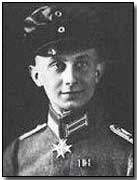Who's Who - Kurt Wolff
 Kurt Wolf (1895-1917) was one of
Germany's highest-scoring
air aces of
the First World War, amassing some 33 victories prior to his death during
active service on 15 September 1917.
Kurt Wolf (1895-1917) was one of
Germany's highest-scoring
air aces of
the First World War, amassing some 33 victories prior to his death during
active service on 15 September 1917.
Born on 6 February 1895 in Griefswald, Pomerania and orphaned while young, Wolff enlisted with the Eisenbahn Railway Regiment Number 4 in Schoesberg in 1912 while aged 17.
Receiving his commission in April 1915 he applied for and received a transfer to the German Imperial Air Service three months later. His early training was inauspicious: on his first instruction flight his instructor was killed while Wolff himself escaped with a dislocated shoulder.
Emerging from his period of training with a pilot's certificate in December 1915 Wolff saw service at Verdun in early 1916 with a KG unit and later that year during the closing stages of the Battle of the Somme with Jasta 11.
Known as 'tender little flower' among his fellow pilots ('zarte Bluemlein') for his shy demeanour Wolff was not initially a successful fighter pilot. It was only with the arrival of Manfred von Richthofen to command of Jasta 11 that both Wolff's and Jasta 11's performance picked up.
Wolff achieved the first of his 33 victories on 6 March 1917, bringing down a British B.E.2d reconnaissance aircraft. In the space of just two months Wolff worked hard to make up for lost time, downing 29 aircraft.
The recipient of Germany's highest military award, the Pour le Merite, on 4 May 1917, Wolff was handed command of Jasta 29 two days later, an appointment which brought a mixed reaction, Wolff believing that he was better while being led than leading by example himself. However late the following month Wolff was recalled to Jasta 11 as its commander (Richthofen having since been appointed to command of the first Jagdgeshwader).
Receiving an injury - shot through the hand - during a fight with no fewer than eleven British Sopwith Triplanes on 11 July Wolff was removed from active service until 11 September. The day following his return to duty he was promoted to Oberleutnant.
Four days later, on 15 September 1917, Wolff was shot down in the air above Moorslede while fighting Sopwith Camels attached to the British No. 10 Naval Squadron; Norman McGregor claimed the victory. Wolff's aircraft - one of the new Fokker Triplanes - crashed behind German lines and he was afforded a burial with full military honours.
A "Bangalore Torpedo" was an explosive tube used to clear a path through a wire entanglement.
- Did you know?
